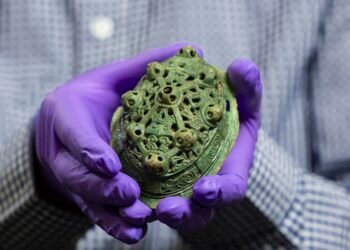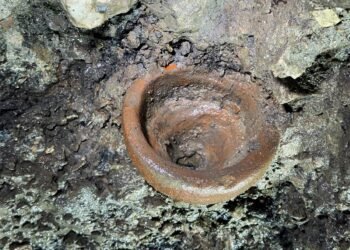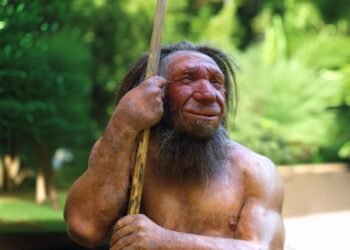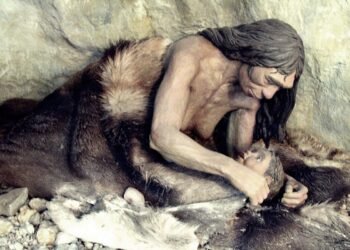A team of paleoanthropologists, led by Christopher J. Bae from the University of Hawai‘i at Mānoa and Xiujie Wu from the Institute of Vertebrate Paleontology and Paleoanthropology at the Chinese Academy of Sciences, has introduced Homo juluensis, a newly identified hominin species. This species, whose name translates to “big head,” thrived in eastern Asia between 300,000 and 50,000 years ago, marking a significant addition to the Late Quaternary human lineage.

Homo juluensis is defined by a mix of features found in fossils from sites such as Xujiayao and Xuchang in northern and central China. The fossils include large crania with thick skulls, traits reminiscent of Neanderthals, as well as characteristics shared with modern humans and Denisovans. The species is thought to have been skilled in making stone tools, processing animal hides, and hunting wild horses, which likely contributed to their survival in challenging environments.
For years, paleoanthropologists have grappled with the so-called “muddle in the Middle,” a term describing the confusion surrounding the classification of Middle Pleistocene hominin fossils. Many specimens were grouped into broad categories like “archaic Homo sapiens” or “Middle Pleistocene Homo.” However, Bae and Wu’s work proposes a more nuanced taxonomy, suggesting that eastern Asia hosted at least four distinct hominin species: Homo floresiensis, Homo luzonensis, Homo longi, and the newly named Homo juluensis.

In a May 2024 study, Bae and Wu argued that fossils previously categorized as belonging to Denisovans, including remains from Tibet, Taiwan, and Laos, could also belong to Homo juluensis. This hypothesis is based on similarities in jaw and teeth structures among fossils from these regions.
The research team emphasized that naming Homo juluensis is not merely about taxonomy but about improving science communication. “This study clarifies a hominin fossil record that has tended to include anything that cannot easily be assigned to Homo erectus, Homo neanderthalensis, or Homo sapiens,” Bae explained in a press release. “Ultimately, this should help with science communication.”
In a commentary in Nature Communications, Bae and Wu highlighted the importance of new terminology for understanding evolutionary models. “Thanks largely to a growing hominin fossil record, the field of Late Quaternary eastern Asian paleoanthropology is contributing tremendously to how we view and refine these models,” they wrote.
Homo juluensis challenges unilineal evolutionary models. According to the researchers, the eastern Asian fossil record underscores the need to revise traditional interpretations of human evolution to reflect the diversity and hybridization events revealed by recent findings. The discovery of Homo juluensis marks a significant step forward in unraveling the intricate web of human ancestry.























There is only one correct interpretation of the mass of data about human origin…and it requires fitting into a larger picture based on the evolution of human intelligence IQ, and the emergence of emotion as a key catalyst. Asia is a dead end for hominin evolution, because the key mutation/good feeling for speech and dance, happened randomly in Africa in H.S. After that…the winer takes it all.
Not sure if you have the answer here. My theory is that Homo Neanderthalis was a noble, honest, kind, yet guilless species and Homo Sapiens were a more handsome, but physically weaker and sinister species. They superseded the Neanderthals through trickery and surreptition, stabbing them in their backs, taking advantage of their innocence and eventually, through the centuries, wiped them out simply by way of their cruelty.
Even though we were weaker and less intelligent, we lacked kindness and honesty, and eventually through evil malevolence took advantage of the Neanderthals until the Neanderthals were all gone. Just by being dishonest and vile.
The Neanderthals had bigger brains and more robust physiques, they were stronger and smarter. How else would we have superseded them? This is the only logical assumption. It was by trickery and surreptition. They were honest and trusting and we killed them for that.
How could you possibly conclude this based on bones, tools, and cave drawings? If Neanderthals were more intelligent than Homo Sapiens why did they not invent the bow and arrow, the wheel, and a thousand other advancements despite having been around much longer than Homo Sapiens?
Nicholas. Inventions comes from need. If you do not have any use for the wheel, why invent it? It is a fairly late invention btw. Mayans had no wheels due to the fact it was useless in the environment they lived in and lack of draft animals but they knew of the concept. Neanderthals may well have known the concept but lack of domesticated draft animals did that they never developed it further. Same thing could apply for bow and arrow. Hunting techniques were sufficent for their needs.
I agree w/ u 100% they were “Able” and WE were Cain, as told in the Bible. Able was all those traits u had mentioned, “right with God”, and we in our jealousy killed them for it. Human isn’t aligned w/ nature. We eradicate because “they’re different”, often w/ pleasure. Only other species that enjoys revenge consistently that I’m aware of is chimps, of course our closest relatives. No other species holds the desire to eradicate so high. We didn’t out compete all other species; we simply were more effed up in the head and therefore insisted we wipe all others out!! And the mentality will forever be on display cause it’s always “us & them”.
Tragic brutality survives most easily. God bless.
“Scientists at the Max Planck Institute of Molecular Cell Biology and Genetics in Dresden, Germany, said they have identified a genetic mutation that triggered the faster creation of neurons in the Homo sapiens brain. The Neanderthal variant of the gene in question, known as TKTL1, differs from the modern human variant by one amino acid…This shows us that even though we do not know how many neurons the Neanderthal brain had, we can assume that modern humans have more neurons in the frontal lobe of the brain, where TKTL1 activity is highest, than Neanderthals.”
Sept 8 2022
Summary: We have more neurons than neanderthals had where it really counts.
Big brain size does not necessarily mean more neurons. Bird brains have much higher density of neurons than mammals, so it is a good thing our brains are so large.
They are continually coming up with the latest ” most definitive” earliest finds about our ancestors. I firmly believe they are all just throwing darts and guessing so they can come up with a new un-pronouncable name. I want one named Bob!
Everyone keeps ignoring ICE-AGES !
Every ice-age the TROPICS regions of the world became cooler and hotbeds of genetic interchange as exo-Tropics regions became too cool or crowded to survive in. At the same time sea-levels fell dramatically, so places like the mediteranean became a lush river & lake valley, even east-asian island became a single land mass or navigable by inshore boats. So its “Out of the ICE-AGES” not “Out of Africa”!
DNA from the Harbin skull indicates that Harbin man–the Harbin, DaLi, and Jinniushan
specimens all assigned to Homo Longi are Denisovans, but some claim that Homo Juluensis
are the “real” Denisovans. Is it possible that Homo :Longi and Homo Juluensis are just two
subspecies of the same species–or that maybe the Denisovans represent at least two or
more distinct species? I am finding these claims very confusing, And then there is the
MaBa Specimen and several others which are different from both the claimed Homo Longi
and Homo Juluensis specimens…..Things are much simpler in the Middle East: there are
probably only two species do deal with: Neanderthals (which can be divided two groups (early: Nesher Ramla and Zuttiyeh) and semi-classic(Tabun, Amud,
Shanidar, Kebara, Dederiyeh and Teshik Tash), and modern humans. I use the
term semi-classic because the Middle Eastern Neanderthals are less extreme
in some of their features than the European ones, e.g. they are slightly taller than
their European counterparts. But these differences are not enough to justify
putting them into a separate species; the differences are more like the differences
between a Swede and an Italian……